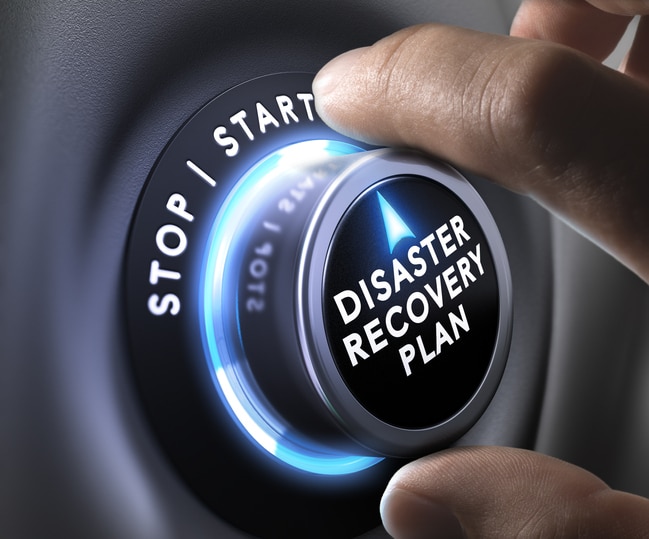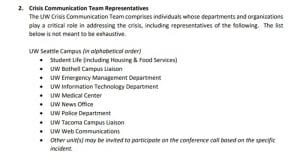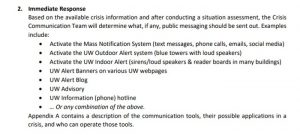
A crisis is an event that threatens your company’s ability to conduct business. Crises could be expected or unexpected. For example, if you’re planning to lay off employees, it’s fair to anticipate some form of crisis. However, in most cases, crises are unexpected, leaving brands playing catch up and they can be very difficult to deal with.
Here is the crazy thing, though. According to a 2021 PWC global crisis survey, 95% of business leaders had anticipated that a global crisis was imminent in 2019. I will let that sink in but – less than 35% had implemented a crisis response program that was relevant and updated. I have been asking people whether they have a plan myself anecdotally as this genuinely interests me.
That speaks to the wider problem of businesses failing to prepare for a crisis. What’s worse is that the more ill-prepared you are, the higher the chance your business could come to its knees when faced with crises of any type and size. That’s a terrible spot to be in, right?
So, in this post hopefully, you’ll learn the fundamentals of PR crisis management so you know how to prepare for a crisis by creating a solid crisis communication plan. OK so let’s get right into it.
-
Create A Crisis Management Team
The crisis management team is responsible for all information flowing in and out of your organisation. They are expected to disseminate key messages to stakeholders and the media. They are also supposed to monitor the general public’s response to the crisis and how people are reacting to each piece of information shared by the company.
Your crisis management team is critical in determining how well your organisation handles a crisis. Consequently, you have to pick the team carefully and have everyone understand their roles in advance. You need to be as clear as possible on roles as trust me it can get confusing if you don’t.
A crisis management team can take many shapes. For example, the University of Washington crisis communications plan features a team of representatives from various key departments.

In a corporate setting, the company’s MD or CEO could chair the team. Then, you’ll have your internal head of PR and the company’s legal counsel advising the CEO. In addition, you may have heads of different departments within the company on that team. I like this period as this is when PR people genuinely get the respect we deserve. All of a sudden a PR person is very important and gets the seat at the C-Suit table.
After creating the team, you’ll need to specify the roles of each team member. Start by identifying the spokesperson who will interact with the media directly. That could be your PR executive or a high-ranking person in the organisation. You also want another member handling internal communications as that can get bumpy too if not handled carefully.
It’s best to have backup personnel for each role. You also want contact details for every team member, including an emergency contact. It would be unfortunate for your PR executive to be unreachable when your brand gets hit with a major PR crisis. In my experience a true PR crisis never usually happens between 9-5pm either you can be damn sure it is 7pm on a Friday night as you are just settling in to your second glass of wine.
Something else you may want to consider is to contract a PR agency or independent crisis contractor. As you may already know, crises come in different forms and sizes. You may find yourself in a crisis storm too big for your in-house PR executive to handle. It’s also very possible that your organisation doesn’t have a functional internal PR department at all.
In such cases, retaining a PR agency beforehand will streamline your response to the crisis. That increases the chances of coming out the other end with minimal brand damage. Having a PR agency on the books anyway can often stop a crisis even occurring but obviously the earlier you have the resource and extra experience on-board the better.
2. Build A Contacts List
Talk to anyone who’s ever been in a crisis communication team before, and they’ll tell you things tend to move too fast during a crisis. That’s why you must have all critical details captured in your crisis communication plan. A contacts list is one of those details.
The list should contain the contact information of vital external stakeholders you may need to work with during the crisis. For example, you might want the contact details of reporters at a local news outlet to set the story straight as quickly as possible once the crisis hits.
You can’t ignore the role digital channels like social media play in crisis management. Bloggers and influencers can all be instrumental during crisis management. Therefore, draft a contact list of reputable niche influencers and bloggers that could assist with your crisis communication efforts. You can use them as your brand advocates and champions and this can be a masterstroke in the time of a nasty crisis.
3. Identify Key Stakeholders
Next step, you need to identify the key stakeholders for your organisation. Stakeholders here refer to individuals likely to be affected during a crisis. Now, different people could be affected depending on the specific type of crisis.
For example, in the event of local protests, almost everyone from your employees to your customers and the general public living near your company may be affected. Meanwhile, in a tech-related crisis, your customers and maybe employees are likely to be the biggest victims.
Identify all key stakeholders. That might include your employees, customers, investors, business partners, the government, etc. Thinking about how to engage with these groups will reduce the chance of making a mistake when under pressure, which is what a crisis management plan is for. Prepare.
Be sure to share accurate and updated information with the stakeholders during a crisis. How you engage employees is critical. Remember, your staff may talk about the crisis with friends and family. Those contacts share the information with even more people, which is how the rumour mill gets going.
By ensuring stakeholders know what is happening in a crisis, you reduce the chance of misinformation spreading. It also ensures your perspective is part of the unfolding story.
4. Create a Social Media Plan
Social media is an integral part of modern crisis management. Some crises start from social media. For example, a dissatisfied customer who shares their story on Twitter could very easily go viral.
If that happens then your brand is trending online for all the wrong reasons. It’s an all too common event.
Remember when Sephora found itself in such a situation after a single tweet from Sza?
You are a part of the Sephora family, and we are committed to ensuring every member of our community feels welcome and included at our stores.
— Sephora (@Sephora) May 1, 2019
On the bright side, social media can also prove resourceful when handling a crisis. The channels give you a platform to address your customers directly and quickly. It allows you to respond to dissatisfied customers, share your action plan for resolving the crisis, disseminate factual information regarding the story, etc.
But, of course, you will only benefit from the platforms if you have a solid strategy. So, while crafting your crisis communication plan, think about the role of social media and how your brand can use it to get ahead of the situation.
For starters, you can use social media to disseminate information. It’s a great way to connect directly with your audience and share key messages.
The CEO of Air Asia took to Twitter after the crash of QZ 8501. He gave regular updates and was roundly applauded for this approach. You can read more about this story in PR Week.

Another crisis communication tip is to use social media to listen to what people say about your brand. You can search your brand name or the individuals involved in the crisis to see what people are saying.
You can use social listening tools like Buffer, Meltwater and content tool Buzzsumo. Social listening tools make it easier to track mentions on social media during a crisis. You can adjust your crisis management strategy based on the responses and reactions you are seeing.
Social media also allows you to ensure your story is heard. You can use social media platforms to share the facts and tell the public what your brand is doing about the situation. That’s what KFC UK did during the 2018 supply chain crisis.
There’s gossip in the hen house, here’s the facts… pic.twitter.com/lEuyiOZx2h
— KFC UK (@KFC_UKI) February 21, 2018
The bottom line is you need a robust social media plan for your business during a crisis. In the crisis communication plan, share brand guidelines for social media channels and nominate who will be responsible for the platforms. For example, the marketing and sales team may need to let the PR and legal team take the lead on your social media accounts during a PR crisis.
5. Draft Key Responses
The idea here is very simple. What questions are you likely to receive when your company is in a crisis? While you cannot predict everything, there are various questions that you can anticipate and prepare for in advance.
Let’s assume a massive data breach crisis hits your company. Some of the common questions you might expect include;
- How many customers were affected?
- What type of data was stolen?
- What should the customers do in the wake of the data breach?
These are all critical questions. You need to think about how to answer them appropriately.
Prepare for the questions and draft the responses in advance. You want scripted answers that you can tweak based on the situation you find yourself in. After all, it’s easy to get confused and say the wrong things in the heat of a crisis.
If you cannot craft entire responses, note important points that the crisis communications team should remember when writing responses during an actual crisis. For example, from the US the Virginia Department of Education shares some pointers on how schools should communicate with parents during an emergency at school.
So, think about the different types of crises that you could find yourself in. Then, get the crisis communications team together for a brainstorming session to identify possible questions that could arise from each crisis. From there, consult your PR executive or agency and the legal counsel to craft key responses to those questions. Have fun with it – try and go through every scenario that could possibly go wrong. There is no chance in hell you will get them all but it can be fun and challenging trying to do so.
6. Establish A Monitoring and Alerts System
It’s impossible to predict every crisis. However, with proper brand monitoring and alert systems, you can catch many crises in their early stages and resolve them before they get out of hand.
Let’s think about a product fault for a moment. In most cases, such an issue would start with a few customers complaining to your customer care and on social media. If you have a proper monitoring system, you’ll identify those complaints quickly. You might even be able to devise a resolution before the problem worsens.
The best part is multiple tools can monitor your brand mentions and issue alerts based on the triggers you set. For example, you can monitor specific mentions, or search queries.
For instance, brands like Samsung and Tesla could track mentions like “Samsung battery explode” and “Tesla EV crashes,” respectively. That will help the brands get an alert when searches or mentions related to those keywords are used.
Additionally, you can track vendors, suppliers, clients, and key persons related to your organisation, e.g., your CEO and CFO’s names.
Going back to the example of a product fault, monitoring the common complaints received by your customer reps can also warn you of an impending crisis. For instance, if you are receiving a lot of reports about a particular product, it’s best to take a closer look.
7. Review Common Crisis Scenarios
Creating and analysing a hypothetical crisis is critical when developing a crisis communication plan. Not only that, but it can also hugely benefit your crisis response strategy.
How? These hypothetical crises can help your team role play different scenarios, and consider best outcomes. Your team can then use the insights gained through role play and group discussions to refine the communication and response strategy.
For example, in one of the hypothetical crises, you may realise you have information gaps. Being unaware that a problem is brewing means you take a long time to respond. You can use those insights to adjust your internal operations.
Or perhaps, you might realise your holding statement is not transparent. You’d need to review and revise your strategy.
As you can imagine, your team will come up with much better drafts doing this in advance. Everything is a lot easier when you’re not under pressure from an existing crisis.
8. Set Internal Procedures
In your crisis communications plan, lay down the internal procedures to be followed during a crisis. For one, you must determine how you will distribute information to staff. You want to use multiple communication channels to ensure your message is getting out there.
For example, in the event of a security-related crisis, you want to send notifications through emails, SMS, and other channels. Using multiple channels increases the chances of your employees seeing that critical notification.
Looking back at the University of Washington’s crisis communications plan, you can see they provide details on communication channels the team can use based on the type or size of the emergency.

You want key personnel to role-play common eventualities. Be sure to provide key staff with the necessary skills they need to operate effectively during a crisis. For example, you want your company spokesperson to be comfortable in front of the press. That means giving them media training.
Moreover, set some ground rules on things like talking to the media and using social media during a crisis. Let your employees know who they should refer inquiries to during a crisis.
Closing my crisis tips
If you work in marketing or PR there’s a good chance you will work at a company that experiences a crisis during your professional career. That’s almost inevitable. Having a crisis communication plan in place when a crisis occurs increases the likelihood that things are handled calmly and professionally. Companies that have such systems in place are far more likely to come out of a crisis with their brand reputation intact and in some cases stronger.
In my guide above you learned eight critical elements your crisis communication plan needs to succeed. Start by creating a crisis management team and building a contact list. Next, identify key stakeholders and create a social media plan.
From there, draft key responses, establish a monitoring & alert system, and review common crisis scenarios. Finally set internal procedures to be followed during a crisis.
Don’t wait until a crisis hits to start appointing a spokesperson and craft your responses. Instead, use my guide to create a solid crisis communication strategy beforehand. That will give you the best chance at keeping your brand intact even during the worst of crises. Good luck.



